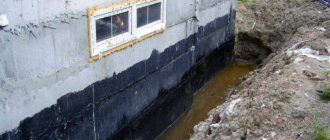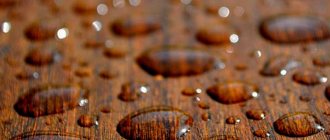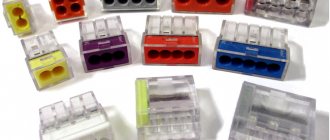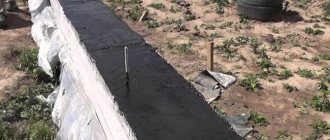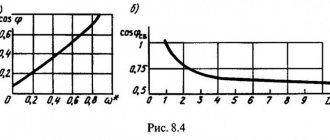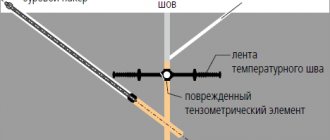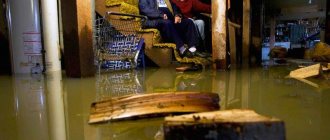When constructing buildings of any type, one of the main issues is waterproofing the foundation, floor, walls and other structural elements. Excess moisture aggressively affects porous materials such as brick and concrete, increasing the number of micropores and microcracks, which causes accelerated destruction of the building structure.
Coating waterproofing is one of the most affordable ways to create a waterproofing layer; it is used for both external and internal work. It is, as a rule, a multilayer coating, the thickness of which ranges from several millimeters to several centimeters.
Bitumen-based coating waterproofing
Traditional coating waterproofing materials are bitumen mastics. Advantages of a bitumen-based waterproofing protective layer:
- surfaces coated with bituminous materials have a high degree of protection from moisture;
- the waterproofing layer is elastic, simple to install, work can be carried out even at sub-zero temperatures;
- bituminous materials are affordable.
Materials for coating waterproofing must comply with GOST “30693-2000 Roofing and waterproofing mastics”.
The main disadvantages of bitumen waterproofing:
- the bitumen protective layer is short-lived - its service life is about 6 years;
- loss of elasticity and fragility already at a temperature of 00C, due to which the coating begins to crack and peel;
- the high temperature at which insulation work is carried out makes it a fire hazard.
Features of using coating waterproofing
Of all the listed materials for coating waterproofing, it is necessary to correctly select the most suitable option. This is explained by the peculiarities of using coating-type waterproofing.
If the foundation experiences insignificant groundwater pressure during operation, then it is possible to waterproof its surface with hot bitumen-based mastic. The use of cold bitumen mastic is not allowed even if there is the slightest groundwater pressure on the foundation walls.
A fairly significant factor is the temperature of the air and the base when carrying out waterproofing work. Most formulations have recommendations on surface temperature, which should not be lower than +5 degrees. In particular, we are talking about water-based bitumen mastics and cement mixtures. Mastics based on organic solvents can be used at negative air temperatures, but provided that the surface is absolutely dry. Otherwise, the bitumen composition will begin to peel off from the surface.
The type of surface is no less important. For example, bitumen mastics require a perfectly flat primed surface; in most cases they are used for concrete, iron and wooden surfaces. Cement-based waterproofing compounds can be used on any surface, including brick. However, it is worth considering their high cost and more careful care after application.
You should also pay attention to the speed of application of some types of coating-type waterproofing materials. For example, when processing large areas, it is better to give preference to bitumen-latex emulsions, the speed of application of which is increased through the use of special devices. Some compositions become thick after a certain time, therefore, during long-term work they must be heated or a special solvent added to the mixture. Bitumen mastics that are used in cold weather should also be heated.
Bitumen-polymer coating insulation
To obtain higher performance characteristics, polymers and latex are added to bitumen mastics. These supplements serve to:
- increasing the elasticity of waterproofing;
- improving the adhesion of mastic to the treated base;
- expanding the temperature operating range of mastics.
Bitumen-polymer mastics of various brands can be intended for both hot and cold application of waterproofing compounds.
If the developer does not want to heat the mastic, then he can purchase a material that retains its liquid consistency thanks to organic solvents.
Bitumen-containing mastics based on organic solvents are used for outdoor work or in rooms with an effective ventilation system. Recommended for treating small surfaces.
An example of such a waterproofing material is the fully ready-to-use one-component bitumen-polymer composition “Slavyanka”. It is a homogeneous pasty mass of black color. It is used for processing concrete, reinforced concrete, metal building structures. Can be used for non-residential premises with high humidity - bathrooms, showers, laundries.
It is prohibited to use Slavyanka coating waterproofing for treating residential surfaces. Work should be carried out away from open flames in an open space or in well-ventilated areas.
Coating waterproofing: pros and cons
To protect a construction site from moisture, 3 types of waterproofing are used. Each of them, like the coating method, has its own advantages and disadvantages.
- Pasting waterproofing . Vertical and horizontal surfaces are covered with layers of rolled materials (waterproof films). The relative cheapness of this method of moisture protection is attractive, but film materials are the least reliable and durable of waterproofing materials.
- Coating penetrating waterproofing .
A penetrating protective layer protects the structure from water and aggressive compounds: gasoline, technical oil and other petroleum products. This type of waterproofing attracts the attention of many due to the speed and ease of use of foundation-impregnating compounds: a coating penetrating moisture insulation is applied to wet concrete without prior drying or treatment. The mixture, consisting of cement, quartz sand and special granulations, contains catalysts that ensure the penetration of the coating into the treated surface. The most reliable and expensive method of waterproofing - high financial costs are the only drawback of this method. - Coating waterproofing. The most common way to protect structures from capillary moisture and groundwater.
Advantages:- Easy to apply protective layer.
No qualified workers are required.
- Affordable price.
Flaws:
- Fragility and fragility of the coating.
- The cheapest material - bitumen without organic additives - cracks and flakes already at zero temperature.
- The slightest mechanical damage to the cover leads to significant destruction of the protective layer.
- New generation compounds are more adapted to adverse conditions and durable, but they significantly increase the cost of construction work.
Return to content
Features of the use of bitumen-polymer emulsions
To carry out waterproofing work indoors, for example, in the basement, it is advisable to use water-based bitumen-polymer waterproofing.
When using bitumen-polymer emulsions at positive temperatures, waterproofing characteristics of the surface are guaranteed that are not inferior to the properties of a hot-applied bitumen-containing coating. The high rate of hardening of this material makes it possible to speed up the pace of waterproofing work by reducing process pauses.
Latex-based mastics, otherwise called liquid rubber, make it possible to carry out mechanized waterproofing work. Their productivity can reach 1000 m2 per day.
KNAUF-Flachendicht is a solvent-free rubber-bitumen emulsion that has good adhesion to concrete, cement, gypsum, lime plaster, plasterboard and gypsum fiber sheets. The emulsion is harmless to human health, odorless and tasteless, and also collects positive consumer reviews:
Areas of application for KNAUF-Vlachendicht waterproofing:
- insulation of places where water can get in before laying facing materials on them;
- for processing foundations;
- for general waterproofing of basements;
- for installing a waterproofing layer on flat roofs, terraces, balconies;
- for insulating swimming pools before installing tiling;
- protection against corrosion of metal building structures.
KNAUF-Flachendicht rubber-bitumen emulsion can be used for both internal and external waterproofing work. The waterproofing bitumen emulsion Ceresit CP 41 has similar areas of use. This composition can be used as a primer for bitumen-polymer mastics Ceresit CP 43, CP 44, CP 48.
Characteristics of materials for coating waterproofing
Any building material is endowed with certain technical characteristics; liquid waterproofing materials are no exception in this regard.
Bituminous mastics are applied in a layer of up to 5 mm; they can stretch up to 300% when broken. Softening of the material occurs at a temperature of 1000C, and the operational period is up to 6 years.
Cement-polymer mastics are applied in a layer of up to 4 mm, provide good adhesion to concrete, but become brittle at temperatures below -200C. Flawless operation of such compositions is ensured for 5-8 years.
The protective coating made of polymer mastics has a thickness of no more than 2 mm; when broken, the material can elongate by 300%. It is recommended to apply the material at temperatures from +5 to +30 degrees, and to use - from -30 to +60 degrees. If all conditions are met, the service life can be about 15 years.
Areas of application of cement-polymer coating waterproofing
Another type of coating waterproofing is cement-polymer materials, which contain cement and plasticizing additives.
Cement coating waterproofing Bergauf Hydrostop is made from cement as a base with the addition of mineral fillers, quartz sand, and modifying additives - water-repellent and polymer. It is used for insulating swimming pools, the depth of which does not exceed 5 m, for the basement, plinth, and facade of structures. Can be used for interior treatment of rooms with normal and high humidity.
Bergauf Hydrostop waterproofing has effective adhesion to concrete, brick, cement and cement-lime surfaces. The Bergauf Hydroplomba brand is a durable, non-shrinking composition, the hardening time of which is only 3-5 minutes. These waterproofing materials can be used both during construction and during renovation of existing buildings.
The composition and scope of application of IVSIL Vodostop waterproofing is similar to that of Bergauf Hydrostop. The cement-polymer material Vodostop is very economical due to its thin layer of application - about 1.5 mm. If a brush or brush is used for work, then three passes are required, when applying the composition with a spatula - only two passes.
The polymer-cement mixture Ceresit CR 65 is intended for waterproofing swimming pools, hydraulic structures, and water tanks, including drinking water. This composition is vapor-permeable, frost-resistant, has high adhesion to the base, and is resistant to petroleum products.
Technology for applying coating waterproofing
The application technology and manufacturers' recommendations suggest covering the foundation with 2-4 layers of the product, no less.
The exact number of layers depends on the depth at which the foundation is located.
The depth of the base correlates with the thickness of the waterproofing layer as follows:
- Depth more than 5 meters or concrete piles - thickness from 5 mm;
- Depth from 3 to 5 meters – respectively 2-4 mm;
- Depth up to 3 meters – 2 mm thickness.
The technology for applying the material must be carefully followed according to the manufacturer's recommendations.
Waterproofing layers are applied independently of each other; before applying the next one, the previous one must dry thoroughly. If the next layer is applied to a damp surface, then after some time it may peel off, then air and moisture enter, which have a destructive effect on the foundation.
How can you tell if the waterproofing layer is dry enough? This is not difficult to do; all you need to do is run your palm over the surface. If it sticks and sticks to the skin, then it has not dried out yet.
Dried mastic is soft and elastic to the touch. The drying speed of each individual layer depends on the manufacturer of the material, its composition, the humidity of the surface being treated and the ambient temperature.
Work order
Let us note an important condition. Before you begin applying waterproofing material, you need to properly prepare the base. Only in this case will the working qualities of the waterproofing layer work fully.
Before processing, the foundation must be well cleaned of adhering dirt and dust; its edges should be carefully cut off or gently rounded to remove any sharp edges and transitions. In the places where the horizontal turns into the vertical, special fillets must be provided that guarantee the intersecting surfaces the greatest possible smoothness.- All irregularities and depressions in the concrete surface that appear in place of burst air bubbles must be carefully leveled with gypsum or cement mortar. This is the only way to protect the future layer of mastic.
- Sharp ridges and prickly protrusions pose a danger to the coating layer. Such uneven joints are not uncommon in formwork joint areas. All dangerous edges must be sanded or hewn away.
- Soil, dirt and dust are removed from the surface, then degreased using an organic solvent.
- The surface to be treated must be well dried.
The quality of adhesion between the base surface and the applied mastic depends on such an indicator as the moisture content of the foundation. Even low humidity levels can cause deformation of the surface of the protective layer.
The connection between the base and the mastic is broken, it does not hold well, and can peel off and even fall off over time. What humidity indicators are considered the maximum permissible?
For polymer-bitumen and bitumen insulation they should not exceed 4 percent, and for water-based insulation they are slightly higher - 8 percent.
It is strictly forbidden to cover a wet surface with coating mastic.
How do you know if the base has dried enough and can you start working on it? There is a very simple method: a polyethylene film is spread over approximately a square meter of base area. If condensation does not appear from inside within a day, you can start working.
What is a primer? Application rules
A primer is a special type of bitumen primer, which contains various mineral components. They help improve the adhesion of the mastic to the concrete base, providing the material with optimal adhesion.
For each type of foundation, primaries are selected individually. Primer compositions for rubble and brick structures have the highest cost.
To make the primer, use bitumen grade BNK 90/30 or BN 70/30; nefras or gasoline is used as a solvent. The heat resistance of this mixture does not exceed 80 degrees.
For each type of mastic, the primer is selected individually: it is applied evenly over the entire surface in one layer. In the case where there are joints of horizontal and vertical concrete slabs in the foundation, it is worth applying two layers.
The composition is applied with a brush or roller, then wait for it to dry completely.
The coating mastic is applied as follows:
Application is carried out strictly from the water pressure side, always on the prepared surface. Most often it is the outer side of the foundation. However, in some cases, for example, in the presence of an underground garage or basement, waterproofing is also applied from the inside.- To apply the product use a brush or roller. Application is carried out layer by layer and evenly. Each next layer should be uniform and without breaks. Coating waterproofing is applied in parallel strokes, from bottom to top.
After the previous layer has completely hardened, you can move on to the next one.
Work on installation of coating waterproofing
To form a high-quality waterproofing layer, it is very important to carry out high-quality surface preparation. To do this you should:
- remove all corroded areas, oil and dirt stains using brushes, scrapers or other means;
- dusty surfaces are blown with compressed air, washed and dried;
- cracks and potholes are sealed with cement-sand mortar;
- if the reinforcement protrudes above the surface, then it must be cut off, filling the resulting cavity with a solution;
- the cleaned surface is treated with a primer - a waterproofing material with a more liquid consistency;
Coating waterproofing is applied in at least two layers, each layer thickness is 2-4 mm.
Video about the use of coating waterproofing
In this video you can clearly see the technology of using waterproofing compounds. Instead of those indicated in the video, you can use those recommended in the article or others similar.
How to waterproof a floor in a house over a reinforced concrete floor?
Let's look at how to waterproof a floor in a house over a reinforced concrete floor using the coating method. In this case, you should follow the instructions for using a particular material for waterproofing.
Namely:
- Follow the composition exactly. Many materials are sold in the form of dry mixtures; the slightest violation of the solution preparation technology can ruin the highest quality product;
- Observe the hardening time exactly . Each waterproofing material has a certain hardening time. Rushing this process will result in loss of strength and durability of the waterproofing.
Work order:
Waterproofing a concrete floor must be done on a rigid base, without chips, cracks or potholes. In many houses, the reinforced concrete slab that serves as the base of the floor almost always has bumps, depressions and differences in height, so a concrete floor screed is made over such a surface. In this case, the floor is waterproofed before the screed.
(1) The surface must be cleaned of debris using a wire brush, cracks must be sealed with plaster and dried.
(2) Before applying coating waterproofing, the floor surface should be covered with a layer of deep penetration bitumen-water emulsion (primer), which holds together small particles of the insulated surface and promotes strong adhesion of subsequent layers of waterproofing.
(3) Next, a bitumen-water emulsion is applied to the floor. The waterproofing composition is applied in several layers with breaks for drying. At the same time, the continuity of its application is strictly observed, otherwise the waterproofing will lose its meaning.
The joints between the floor and walls, steps or other protruding objects must be coated with a protective layer to a height of up to 30 cm.
Waterproofing the shower floor has its own characteristics. First of all, the joints between the walls and the floor should be protected from water penetration. For this purpose, sealing tape is used.
The order of work is as follows:
- Waterproofing joints Coat the joints with a layer of waterproofing;
- At the joints, glue (press) sealing tape onto the waterproofing, extending onto the floor and walls;
- Coat the edges of the tape generously with waterproofing;
- Apply waterproofing to the floor surface;
- Floor tiles are laid on top of the waterproofing using an adhesive solution.
Important! If the tape will be placed near pipes with hot water or a heating system, then choose a tape that can withstand temperatures of +70ºС.
Waterproofing the floor in a bathhouse or shower is done with materials based on polyurethanes or rubbers.
Remember: in wet rooms, not only the floor, but also the walls need protection from moisture. Therefore, it is advisable to carry out comprehensive waterproofing.
That is, the sealing tape is glued along all the joints of the walls. And the waterproofing materials offered to you fit perfectly on concrete, plaster, plasterboard and gypsum fiber board for the floor.
Types of bitumen-containing coating waterproofing "TechnoNIKOL"
The range of TechnoNIKOL waterproofing materials is extremely wide and includes products for a wide variety of purposes:
- Conventional bitumen mastics for hot use are the cheapest, but require heating during application. These include mastics of the MBK-G series, which belong to economy class products. They are used for external coating waterproofing of a wide variety of building structural elements in all climatic conditions. With constant stirring, the mastic heats up to temperatures of 160-1800C. The base is dusted off, covered with primer, mastic is applied to it with a brush, spatula, or poured and leveled with special scrapers. After cooling, a durable protective layer is formed that has reliable adhesion to the base.
- Hot bitumen-polymer roofing mastic "TechnoNIKOL No. 41" has the main advantage - fast hardening speed. Areas of application: installation and repair of roofs, waterproofing of steel structures, pipes, concrete blocks and columns in direct contact with the ground. Mastic is made from polymer-modified bitumen and mineral materials. The application technology is similar to the use of conventional bitumen mastics.
- Cold application mastic "Tehnomast" ("TechnoNIKOL No. 21") is a completely ready-to-use waterproofing material. It consists of petroleum bitumen modified with artificial rubber, mineral components, and an organic solvent. The mastic is applied to the prepared base with a brush, spatula or pouring method. Areas of application for Technomast are waterproofing foundations, piles, and other objects buried in the ground and in direct contact with a damp environment. Also used for anti-corrosion treatment of metal pipes and automobile bodies.
The thickness of one layer should be no more than 1.5 mm. Each layer is applied only after the previous one has completely dried (drying time - 12-24 hours, depending on the thickness of the layer). For waterproofing, at least two layers are applied.
- Water-emulsion mastic "TechnoNIKOL No. 33" is obtained by dispersing latex-modified bitumen in an aqueous solution of emulsifiers. Waterproofing coatings "TechnoNIKOL No. 33" have an extended operating temperature range. They are used to protect foundations, piles and other structures located in the ground in contact with a damp environment. They are also used for internal waterproofing: in the bathroom, basement, for the floors of balconies and swimming pools.
Prices for coating waterproofing
The decision on the type of waterproofing should be made depending on the type of structure being processed, its operating conditions, the temperature of the work, the budget allocated for this work, and always in agreement with experienced builders. If you decide to buy this type of waterproofing, then this table with approximate prices for various materials will be useful to you:
| Name | units | price, rub. |
| Roofing emulsion mastic TechnoNIKOL No. 31 | 1 PC. (3 kg) | 244-325 |
| Moisture-resistant mastic Knauf Flachendicht | 1 PC. (5 kg) | 920-1082 |
| Waterproofing compound Ceresit CR 65/25 | 1 PC. (25 kg) | 805-850 |
| Waterproofing mastic Slavyanka | 1 PC. (9 kg) | 970-1150 |
| Lakhta coating waterproofing | 1 PC. (25 kg) | 1950-2300 |
| Coating waterproofing Ivsil Vodostop with high water resistance | 1 PC. (20 kg) | 469-516 |
Service life and technical characteristics
Bituminous coating waterproofing will last 3-5 years , depending on operating conditions. The composition loses elasticity at temperatures of 0 degrees and below: as a result, after the first cold weather, the film becomes covered with cracks and peels off.
Today, manufacturers offer more durable products: bitumen-rubber, bitumen-polymer and cement-polymer mastics . New generation waterproofers are more durable, resistant to temperature changes, acidic and alkaline compounds, their service life is about 5 years . At the same time, mastics based on organic compounds are more expensive - if large areas need to be treated, the cost of work will increase significantly. Therefore, for large-scale work, the usual bitumen mastics are usually used.
Bituminous waterproofing is applied quite simply; the work does not require the involvement of qualified workers . A protective composition is applied to the concrete surface in 2-5 layers. The optimal thickness of one layer is 1.5 mm. To apply the mixture, use a spatula, a hard brush or a special sprayer.
Each subsequent layer is applied after the previous one has completely dried. It is considered that the coating waterproofing of the foundation has dried if it does not stick to your fingers when touched - usually the layer dries in an hour.
Return to content

